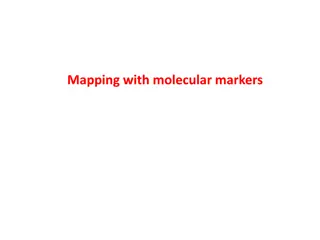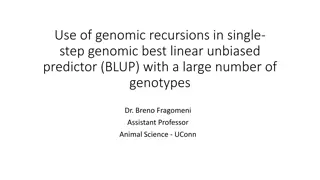Population Generation from Statistics Using Genetic Algorithms with MIST + INSPYRED
This article discusses the use of Genetic Algorithms along with MIST and INSPYRED for generating a mock population from published statistics. It covers the basics of INSPYRED and MIST, their applications in population generation, and the computing power needed for running simulations over the cloud.
Download Presentation

Please find below an Image/Link to download the presentation.
The content on the website is provided AS IS for your information and personal use only. It may not be sold, licensed, or shared on other websites without obtaining consent from the author. Download presentation by click this link. If you encounter any issues during the download, it is possible that the publisher has removed the file from their server.
E N D
Presentation Transcript
Population Generation from Statistics Using Genetic Algorithms with MIST + INSPYRED Jacob Barhak Freelancer Austin, Texas Aaron Garrett Jacksonville State University Jacksonville, Alabama MODSIM World 2014 Conference & Expo Hampton Roads VA, USA 16 April 2014
Background The First Table in a Clinical Trial publication typically contains Population Statistics Summary Data Only: Mean (SD) / Median (IQR) Limited information about distribution Inclusion/exclusion criteria skew the distribution Control Intervention Age 53.3 (8.6) 53.2 (8.6) % Male 61.9% 59.3% Smoke 31% 30% Systolic Blood Pressure (mmHg) 135(20) 135(20) Total Cholesterol (mmol/L) 5.4 (1.02) 5.4(1.12) Example: Excerpt from Table 1 in UKPDS 33 Jacob Barhak
Goal Generate a Mock Population Composed of Individuals from the Published Statistics Individual population is restricted Table 1 is typically public Generate a mock population for further study Population 1 Population 2 Population N Population 2 Table 1 Population3 Table 1 Table 1 Jacob Barhak
INSPYRED Basics Bio Inspired computation Python library Evolutionary Computation Swarm Intelligence Neural Networks Developed and Maintained by Aaron Garrett Jacob Barhak
MIST Basics MIST stands for MIcro-Simulation Tool In a nutshell it is a Monte-Carlo simulation compiler Offers a Domain Specific Language Reproducible simulations MIST Supports Population Generation Generating functions Optimization towards objectives Evolutionary computation with INSPYRED MIST runs over the cloud! And on Sun Grid Engine (SGE) clusters Jacob Barhak
MIST Uses Computing Power Here is Proof! Fried after two year of extensive use Jacob Barhak
MIST Runs Over the Cloud! Anaconda drives MIST to run over the Amazon cloud! Batch mode MIST utilities allow: Submitting jobs to Sun Grid Engine (SGE) Running simulations Generating reports Combining reports from multiple repetitions/scenarios Star Cluster creates an SGE cluster on the Amazon Elastic Compute Cloud The Anaconda Amazon Machine Image (AMI) is used for the cluster master / nodes Good for: Cutting down computation time by renting computing power Saving initial and maintenance costs associated with a cluster MIST Cloud Jacob Barhak
INSPYRED Evolutionary Computation: Population Generation & Objectives Generation Expressions: Define how to generate a single individual Test if individual fits the inclusion/exclusion criteria Define ties and correlations between characteristics INSPYRED MIST Monte Carlo Expression Compiler Evolutionary Computation Selection Result Objectives: Define aggregate targets for the entire population Reduce random generation error Handle skewed distributions to fit target Result Population Converges to Objectives Jacob Barhak
INSPYRED Evolutionary Computation Candidates Generator Evaluator 3.1 7.5 4.2 5.2 Generations / Epocs Selector + = Repeat Variators Parents Crossover Mutation Terminator Best Solution Jacob Barhak
Population Generation Example Skewed by Inclusion/Exclusion Generate 10 people with: Inclusion criteria is 45< Age <90 The base population distribution is: Age for Male: Mean 53 SD 10 Age for Female: Mean 52 SD 7 Male: 50% Age Male 48.85785535 59.94741744 56.19039096 64.40825341 49.77582796 60.29975596 51.27571792 72.13820388 55.51746037 58.72574003 0 0 1 0 1 1 1 1 0 0 Design is Subject to Constraints Generation Functions (Implementation): Age ~ Iif (Male,Gaussian(53,10) ,Gaussian(52,7)) Male ~ Bernoulli(0.5) Assert = And(Gr(Age,45),Ls(Age,90)) Notes: May not represent well what was intended Assertion drops non qualifying candidates The resulting Age is skewed Final population that would have been reported in Table 1: Age Mean: 57.71366233 Age SD: 7.115024093 Male Mean: 0.5 Result to be Published Jacob Barhak
Population Generation Example With Objectives Generate 10 people with objectives: Base distribution & Inclusion criteria as before Age : Mean 50, SD 5 Male: 60% Age Male 50.8953429 53.71135174 52.86278825 46.021901 48.36662032 47.87355499 45.11370607 62.15347882 47.48350736 45.93131347 0 1 0 1 1 1 1 1 0 0 Design = Desired + Constraints Objectives (Implementation): Age Mean: 50 , Weight 1 Age SD: 5 , Weight 1 Male: 0.6 , Weight 10 Notes: Design matches results as much as possible The designer can study effect of constraints Table 1 can now be planned ahead! Final population selected out of 1000 generated candidates: Age Mean: 50.04135649 Age SD: 5.166548964 Male Mean: 0.6 Result to be Published Jacob Barhak
Summary INSPYRED MIST can regenerate mock populations from Table 1 in clinical trials INSPYRED Table 1 Generate MIST MIST and INSPYRED are free and available on GitHub: https://github.com/Jacob-Barhak/MIST https://github.com/inspyred/inspyred Jacob Barhak
This Modeling Technology Opens Possibilities The Reference Model for Disease Progression Uses MIST Reduced Monte Carlo error Reduced User Error Unexplored Future Potential: Planning Recruitment Efforts? Clinical Trials? Other Recruitment Efforts? Jacob Barhak
Acknowledgments Deanna J.M. Isaman - who is the spirit behind the great ideas. She taught me my first steps in disease modeling Morton Brown & William H. Herman for guidance, critical feedback, and growth environment All those who developed free software used: including Python, Anaconda, Python(x,y), numpy, SciPy, nose, winpdb, Star Cluster, Ubuntu, Sun Grid Engine The legacy IEST modeling framework was supported by the Biostatistics and Economic Modeling Core of the MDRTC (P60DK020572) and by the Methods and Measurement Core of the MCDTR (P30DK092926), both funded by the National Institute of Diabetes and Digestive and Kidney Diseases. The modeling framework was initially defined as GPL and was funded by Chronic Disease Modeling for Clinical Research Innovations grant (R21DK075077) from the same institute. MIST is based on IEST. The Reference Model and MIST were developed independently without financial support Jacob Barhak
Questions MIST INSPYRED https://github.com/Jacob-Barhak/MIST https://github.com/inspyred/inspyred Jacob Barhak























